Immediate and Late Effects of Early Weaning on Rat Gastric Cell Differentiation
Abstract
1. Introduction
2. Results
2.1. Early Weaning and Body Mass
2.2. Ontogenic Expression of Genes That Regulate the Differentiation of Gastric Epithelial Cells
2.3. Early Weaning Changes Molecular Markers of Differentiation and the Distribution of Gastric Cells
3. Discussion
4. Materials and Methods
4.1. Animals and Early Weaning
4.2. RNA Isolation, cDNA Synthesis and RT-qPCR
4.3. Protein Extraction and Western Blot
4.4. Morphology and Determination of Parietal Cell Index
4.5. Histochemistry and Immunohistochemistry for Multiple Labeling
4.6. Statistical Analyses
4.7. Ethics Statement
Author Contributions
Funding
Acknowledgments
Conflicts of Interest
Abbreviations
| S | Suckling |
| EW | Early weaning |
References
- Karam, S.M.; Leblond, C.P. Dynamics of epithelial cells in the corpus of the mouse stomach. I. Identification of proliferative cell types and pinpointing of the stem cell. Anat. Rec. 1993, 236, 259–279. [Google Scholar] [CrossRef]
- Karam, S.M.; Leblond, C.P. Dynamics of epithelial cells in the corpus of the mouse stomach. III. Inward migration of neck cells followed by progressive transformation into zymogenic cells. Anat. Rec. 1993, 236, 297–313. [Google Scholar] [CrossRef]
- Hanby, A.M.; Poulsom, R.; Playford, R.J.; Wright, N.A. The mucous neck cell in the human gastric corpus: A distinctive, functional cell lineage. J. Pathol. 1999, 187, 331–337. [Google Scholar] [CrossRef]
- Ramsey, V.G.; Doherty, J.M.; Chen, C.C.; Stappenbeck, T.S.; Konieczny, S.F.; Mills, J.C. The maturation of mucus-secreting gastric epithelial progenitors into digestive-enzyme secreting zymogenic cells requires Mist1. Development 2007, 134, 211–222. [Google Scholar] [CrossRef]
- Bredemeyer, A.J.; Geahlen, J.H.; Weis, V.G.; Huh, W.J.; Zinselmeyer, B.H.; Srivatsan, S.; Miller, M.J.; Shaw, A.S.; Mills, J.C. The gastric epithelial progenitor cell niche and differentiation of the zymogenic (chief) cell lineage. Dev. Biol. 2009, 325, 211–224. [Google Scholar] [CrossRef] [PubMed]
- Mills, J.C.; Stanger, B.Z.; Sander, M. Nomenclature for cellular plasticity: Are the terms as plastic as the cells themselves? EMBO. J. 2019, 38, e103148. [Google Scholar] [CrossRef] [PubMed]
- Goldenring, J.R.; Ray, G.S.; Soroka, C.J.; Smith, J.; Modlin, I.M.; Meise, K.S.; Coffey, R.J. Overexpression of transforming growth factor-alpha alters differentiation of gastric cell lineages. Dig. Dis. Sci. 1996, 41, 773–784. [Google Scholar] [CrossRef] [PubMed]
- Goldenring, J.R.; Nam, K.T.; Mills, J.C. The origin of pre-neoplastic metaplasia in the stomach: Chief cells emerge from the Mist. Exp. Cell. Res. 2011, 317, 2759–2764. [Google Scholar] [CrossRef]
- Radyk, M.D.; Burclaff, J.; Willet, S.G.; Mills, J.C. Metaplastic Cells in the Stomach Arise, Independently of Stem Cells, via Dedifferentiation or Transdifferentiation of Chief Cells. Gastroenterology 2018, 154, 839–843. [Google Scholar] [CrossRef]
- Sáenz, J.B.; Vargas, N.; Mills, J.C. Tropism for Spasmolytic Polypeptide-Expressing Metaplasia Allows Helicobacter pylori to Expand Its Intragastric Niche. Gastroenterology 2019, 156, 160–174. [Google Scholar] [CrossRef]
- Alvares, E.P.; Gama, P. Fasting enhances cell proliferation of gastric epithelium during the suckling period in rats. Braz. J. Med. Biol. Res. 1993, 26, 869–873. [Google Scholar] [PubMed]
- Gama, P.; Alvares, E.P. Early weaning and prolonged nursing induce changes in cell proliferation in the gastric epithelium of developing rats. J. Nutr. 2000, 130, 2594–2598. [Google Scholar] [CrossRef] [PubMed]
- Ghizoni, H.; Figueiredo, P.M.; Moisan, M.P.; Ogias, D.; Osaki, L.H.; Gama, P. Regulation of corticosterone function during early weaning and effects on gastric cell proliferation. Nutrition 2014, 30, 343–349. [Google Scholar] [CrossRef] [PubMed]
- Osaki, L.H.; Gama, P. MAPKs and signal transduction in the control of gastrointestinal epithelial cell proliferation and differentiation. Int. J. Mol. Sci. 2013, 14, 10143–10161. [Google Scholar] [CrossRef] [PubMed]
- Mills, J.C.; Shivdasani, R.A. Gastric epithelial stem cells. Gastroenterology 2011, 140, 412–424. [Google Scholar] [CrossRef]
- Stange, D.E.; Koo, B.K.; Huch, M.; Sibbel, G.; Basak, O.; Lyubimova, A.; Kujala, P.; Bartfeld, S.; Koster, J.; Geahlen, J.H.; et al. Differentiated Troy+ chief cells act as reserve stem cells to generate all lineages of the stomach epithelium. Cell 2013, 155, 357–368. [Google Scholar] [CrossRef]
- Mills, J.C.; Sansom, O.J. Reserve stem cells: Differentiated cells reprogram to fuel repair, metaplasia, and neoplasia in the adult gastrointestinal tract. Sci. Signal. 2015, 8, re8. [Google Scholar] [CrossRef]
- Petersen, C.P.; Mills, J.C.; Goldenring, J.R. Murine Models of Gastric Corpus Preneoplasia. Cell. Mol. Gastroenterol. Hepatol. 2017, 3, 11–26. [Google Scholar] [CrossRef]
- McDonald, S.A.; Greaves, L.C.; Gutierrez-Gonzalez, L.; Rodriguez-Justo, M.; Deheragoda, M.; Leedham, S.J.; Taylor, R.W.; Lee, C.Y.; Preston, S.L.; Lovell, M.; et al. Mechanisms of field cancerization in the human stomach: The expansion and spread of mutated gastric stem cells. Gastroenterology 2008, 134, 500–510. [Google Scholar] [CrossRef]
- Bjerknes, M.; Cheng, H. Multipotential stem cells in adult mouse gastric epithelium. Am. J. Physiol. Gastrointest Liver Physiol. 2002, 283, G767–G777. [Google Scholar] [CrossRef]
- Willet, S.G.; Mills, J.C. Stomach Organ and Cell Lineage Differentiation: From Embryogenesis to Adult Homeostasis. Cell. Mol. Gastroenterol. Hepatol. 2016, 2, 546–559. [Google Scholar] [CrossRef] [PubMed]
- Wright, N. The Gastric Epithelium: Slow Starter in the Stem Cell/Lineage Specification Stakes? Cell. Mol. Gastroenterol. Hepatol. 2016, 2, 538–539. [Google Scholar] [CrossRef] [PubMed]
- Han, S.; Fink, J.; Jörg, D.J.; Lee, E.; Yum, M.K.; Chatzeli, L.; Merker, S.R.; Josserand, M.; Trendafilova, T.; Andersson-Rolf, A.; et al. Defining the Identity and Dynamics of Adult Gastric Isthmus Stem Cells. Cell Stem Cell 2019, 25, 342–356. [Google Scholar] [CrossRef] [PubMed]
- Weis, V.G.; Sousa, J.F.; LaFleur, B.J.; Nam, K.T.; Weis, J.A.; Finke, P.E.; Ameen, N.A.; Fox, J.G.; Goldenring, J.R. Heterogeneity in mouse spasmolytic polypeptide-expressing metaplasia lineages identifies markers of metaplastic progression. Gut 2013, 62, 1270–1279. [Google Scholar] [CrossRef]
- Keeley, T.M.; Samuelson, L.C. Cytodifferentiation of the postnatal mouse stomach in normal and Huntingtin-interacting protein 1-related-deficient mice. Am. J. Physiol. Gastrointest Liver Physiol. 2010, 299, G1241–G1251. [Google Scholar] [CrossRef]
- McCracken, K.W.; Wells, J.M. Mechanisms of embryonic stomach development. Semin. Cell Dev. Biol. 2017, 66, 36–42. [Google Scholar] [CrossRef]
- Kim, T.H.; Shivdasani, R.A. Stomach development, stem cells and disease. Development 2016, 143, 554–565. [Google Scholar] [CrossRef]
- Osaki, H.; Curi, M.A.; Alvares, E.P.; Gama, P. Early weaning accelerates the differentiation of mucous neck cells in rat gastric mucosa: Possible role of TGFalpha/EGFR. Differentiation 2010, 79, 48–56. [Google Scholar] [CrossRef]
- De Andrade Sá, E.R.; Bitencourt, B.; Alvares, E.P.; Gama, P. In vivo effects of TGFbeta1 on the growth of gastric epithelium in suckling rats. Regul. Pept. 2008, 146, 293–302. [Google Scholar] [CrossRef]
- Karam, S.M. Dynamics of epithelial cells in the corpus of the mouse stomach. IV. Bidirectional migration of parietal cells ending in their gradual degeneration and loss. Anat. Rec. 1993, 236, 314–332. [Google Scholar] [CrossRef]
- Laine, L.; Takeuchi, K.; Tarnawski, A. Gastric mucosal defense and cytoprotection: Bench to bedside. Gastroenterology 2008, 135, 41–60. [Google Scholar] [CrossRef] [PubMed]
- Zhu, L.; Hatakeyama, J.; Zhang, B.; Makdisi, J.; Ender, C.; Forte, J.G. Novel insights of the gastric gland organization revealed by chief cell specific expression of moesin. Am. J. Physiol. Gastrointest Liver Physiol. 2009, 296, G185–G195. [Google Scholar] [CrossRef] [PubMed]
- Tian, X.; Jin, R.U.; Bredemeyer, A.J.; Oates, E.J.; Błazewska, K.M.; McKenna, C.E.; Mills, J.C. RAB26 and RAB3D are direct transcriptional targets of MIST1 that regulate exocrine granule maturation. Mol. Cell. Biol. 2010, 30, 1269–1284. [Google Scholar] [CrossRef] [PubMed]
- Furihata, C.; Kawachi, T.; Sugimura, T. Premature induction of pepsinogen in developing rat gastric mucosa by hormones. Biochem. Biophys. Res. Commun. 1972, 47, 705–711. [Google Scholar] [CrossRef]
- Kageyama, T.; Ichinose, M.; Tsukada-Kato, S.; Omata, M.; Narita, Y.; Moriyama, A.; Yonezawa, S. Molecular cloning of neonate/infant-specific pepsinogens from rat stomach mucosa and their expressional change during development. Biochem. Biophys. Res. Commun. 2000, 267, 806–812. [Google Scholar] [CrossRef] [PubMed]
- Roman-Garcia, P.; Quiros-Gonzalez, I.; Mottram, L.; Lieben, L.; Sharan, K.; Wangwiwatsin, A.; Tubio, J.; Lewis, K.; Wilkinson, D.; Santhanam, B.; et al. Vitamin B₁₂-dependent taurine synthesis regulates growth and bone mass. J. Clin. Investig. 2014, 124, 2988–3002. [Google Scholar] [CrossRef]
- Ogias, D.; Rattes, I.C.; Hosoya, L.Y.M.; Zulian, J.G.; Yan, C.Y.I.; Gama, P. Neonatal-maternal separation primes zymogenic cells in the rat gastric mucosa through glucocorticoid receptor activity. Sci. Rep. 2018, 8, 9823. [Google Scholar] [CrossRef]
- Zulian, J.G.; Hosoya, L.Y.; Figueiredo, P.M.; Ogias, D.; Osaki, L.H.; Gama, P. Corticosterone activity during early weaning reprograms molecular markers in rat gastric secretory cells. Sci. Rep. 2017, 7, 45867. [Google Scholar] [CrossRef]
- Osaki, L.H.; Figueiredo, P.M.; Alvares, E.P.; Gama, P. EGFR is involved in control of gastric cell proliferation through activation of MAPK and Src signalling pathways in early-weaned rats. Cell Prolif. 2011, 44, 174–182. [Google Scholar] [CrossRef]
- Osaki, L.H.; Gama, P. MAPK signaling pathway regulates p27 phosphorylation at threonin 187 as part of the mechanism triggered by early-weaning to induce cell proliferation in rat gastric mucosa. PLoS ONE 2013, 8, e66651. [Google Scholar] [CrossRef]
- Bittar, N.M.; Zulian, J.G.; Ogias, D.; Gama, P. Ghrelin and GHS-R in the rat gastric mucosa: Are they involved in regulation of growth during early weaning? Nutrition 2016, 32, 101–107. [Google Scholar] [CrossRef] [PubMed]
- Judd, L.M.; Gleeson, P.A.; Toh, B.H.; van Driel, I.R. Autoimmune gastritis results in disruption of gastric epithelial cell development. Am. J. Physiol. 1999, 277, G209–G218. [Google Scholar] [CrossRef] [PubMed]
- Burclaff, J.; Osaki, L.H.; Liu, D.; Goldenring, J.R.; Mills, J.C. Targeted Apoptosis of Parietal Cells Is Insufficient to Induce Metaplasia in Stomach. Gastroenterology 2017, 152, 762–766. [Google Scholar] [CrossRef] [PubMed]
- Victora, C.G.; Bahl, R.; Barros, A.J.; França, G.V.; Horton, S.; Krasevec, J.; Murch, S.; Sankar, M.J.; Walker, N.; Rollins, N.C.; et al. Breastfeeding in the 21st century: Epidemiology, mechanisms, and lifelong effect. Lancet 2016, 387, 475–490. [Google Scholar] [CrossRef]
- Jacobs, D.M.; Ackerman, S.H. Differential growth rate of rat gastric mucosal cells during postnatal ontogeny. Am. J. Physiol. 1984, 247, G645–G650. [Google Scholar] [CrossRef]
- Ackerman, S.H.; Hofer, M.A.; Weiner, H. Predisposition to gastric erosions in the rat: Behavioral and nutritional effects of early maternal separation. Gastroenterology 1978, 75, 649–654. [Google Scholar] [CrossRef]
- Lin, C.H.; Correia, L.; Tolia, K.; Gesell, M.S.; Tolia, V.; Lee, P.C.; Luk, G.D. Early weaning induces jejunal ornithine decarboxylase and cell proliferation in neonatal rats. J. Nutr. 1998, 128, 1636–1642. [Google Scholar] [CrossRef]
- Passos, M.A.; Passos, M.C.; Oliveira, E.; Trotta, P.A.; Nogueira-Neto, J.F.; Bonomo, I.T.; Lisboa, P.C.; de Moura, E.G. Maternal prolactin inhibition during lactation is associated to renal dysfunction in their adult rat offspring. Horm. Metab. Res. 2011, 43, 636–641. [Google Scholar] [CrossRef]
- Gayle, D.A.; Desai, M.; Casillas, E.; Beloosesky, R.; Ross, M.G. Gender-specific orexigenic and anorexigenic mechanisms in rats. Life Sci. 2006, 79, 1531–1536. [Google Scholar] [CrossRef]
- Lima, N.S.; de Moura, E.G.; Passos, M.C.; Nogueira Neto, F.J.; Reis, A.M.; de Oliveira, E.; Lisboa, P.C. Early weaning causes undernutrition for a short period and programmes some metabolic syndrome components and leptin resistance in adult rat offspring. Br. J. Nutr. 2011, 105, 1405–1413. [Google Scholar] [CrossRef]
- Lima, N.S.; Moura, E.G.; Franco, J.G.; Pinheiro, C.R.; Pazos-Moura, C.C.; Cabanelas, A.; Carlos, A.S.; Nascimento-Saba, C.C.; de Oliveira, E.; Lisboa, P.C. Developmental plasticity of endocrine disorders in obesity model primed by early weaning in dams. Horm. Metab. Res. 2013, 45, 22–30. [Google Scholar] [CrossRef] [PubMed]
- Bouret, S.G.; Simerly, R.B. Developmental programming of hypothalamic feeding circuits. Clin. Genet. 2006, 70, 295–301. [Google Scholar] [CrossRef] [PubMed]
- Balaban, G.; Motta, M.E.; Silva, G.A. Early weaning and other potential risk factors for overweight among preschool children. Clinics (Sao Paulo) 2010, 65, 181–187. [Google Scholar] [CrossRef] [PubMed][Green Version]
- Schuster, S.; Hechler, C.; Gebauer, C.; Kiess, W.; Kratzsch, J. Leptin in maternal serum and breast milk: Association with infants’ body weight gain in a longitudinal study over 6 months of lactation. Pediatr. Res. 2011, 70, 633–637. [Google Scholar] [CrossRef] [PubMed]
- Helander, H.F. Ultrastructure and function of gastric mucoid and zymogen cells in the rat during development. Gastroenterology 1969, 56, 53–70. [Google Scholar] [CrossRef]
- Kataoka, K.; Takeoka, Y.; Furihata, C. Immunocytochemical study of pepsinogen 1-producing cells in the fundic mucosa of the stomach in developing mice. Cell Tissue Res. 1990, 261, 211–217. [Google Scholar] [CrossRef]
- Bockman, D.E.; Sharp, R.; Merlino, G. Regulation of terminal differentiation of zymogenic cells by transforming growth factor alpha in transgenic mice. Gastroenterology 1995, 108, 447–454. [Google Scholar] [CrossRef]
- Takagi, H.; Fukusato, T.; Kawaharada, U.; Kuboyama, S.; Merlino, G.; Tsutsumi, Y. Histochemical analysis of hyperplastic stomach of TGF-alpha transgenic mice. Dig. Dis. Sci. 1997, 42, 91–98. [Google Scholar] [CrossRef]
- Burclaff, J.; Willet, S.; Sáenz, J.B.; Mills, J. Proliferation and Differentiation of Gastric Mucous Neck and Chief Cells During Homeostasis and Injury-induced Metaplasia. Gastroenterology 2019. [Google Scholar] [CrossRef]
- Schmittgen, T.D.; Livak, K.J. Analyzing real-time PCR data by the comparative C(T) method. Nat. Protoc. 2008, 3, 1101–1108. [Google Scholar] [CrossRef]
- Bradford, M.M. A rapid and sensitive method for the quantitation of microgram quantities of protein utilizing the principle of protein-dye binding. Anal. Biochem. 1976, 72, 248–254. [Google Scholar] [CrossRef]
- Fiore, A.P.; Osaki, L.H.; Gama, P. Transforming growth factor β1 increases p27 levels via synthesis and degradation mechanisms in the hyperproliferative gastric epithelium in rats. PLoS ONE 2014, 9, e101965. [Google Scholar] [CrossRef] [PubMed]
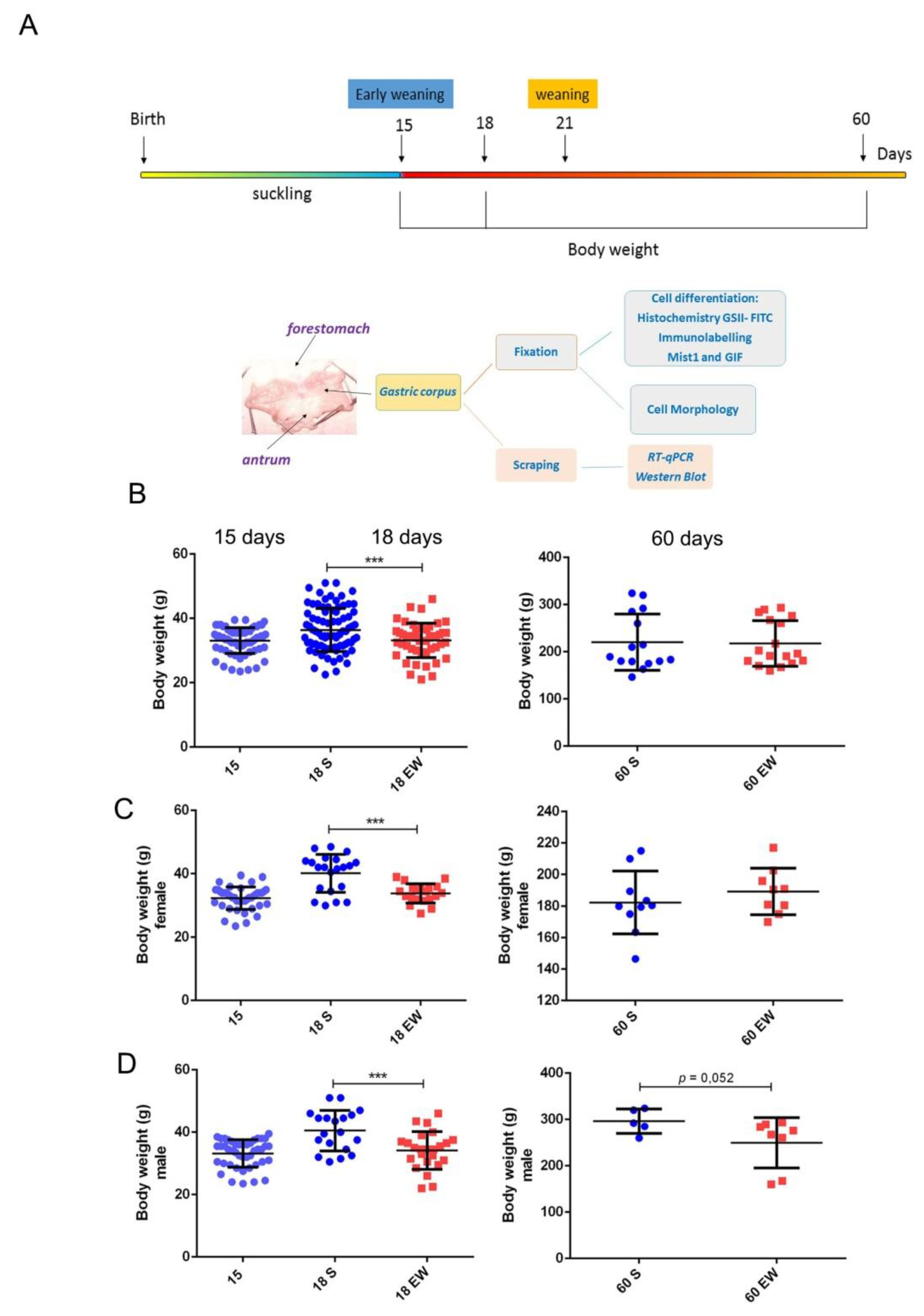
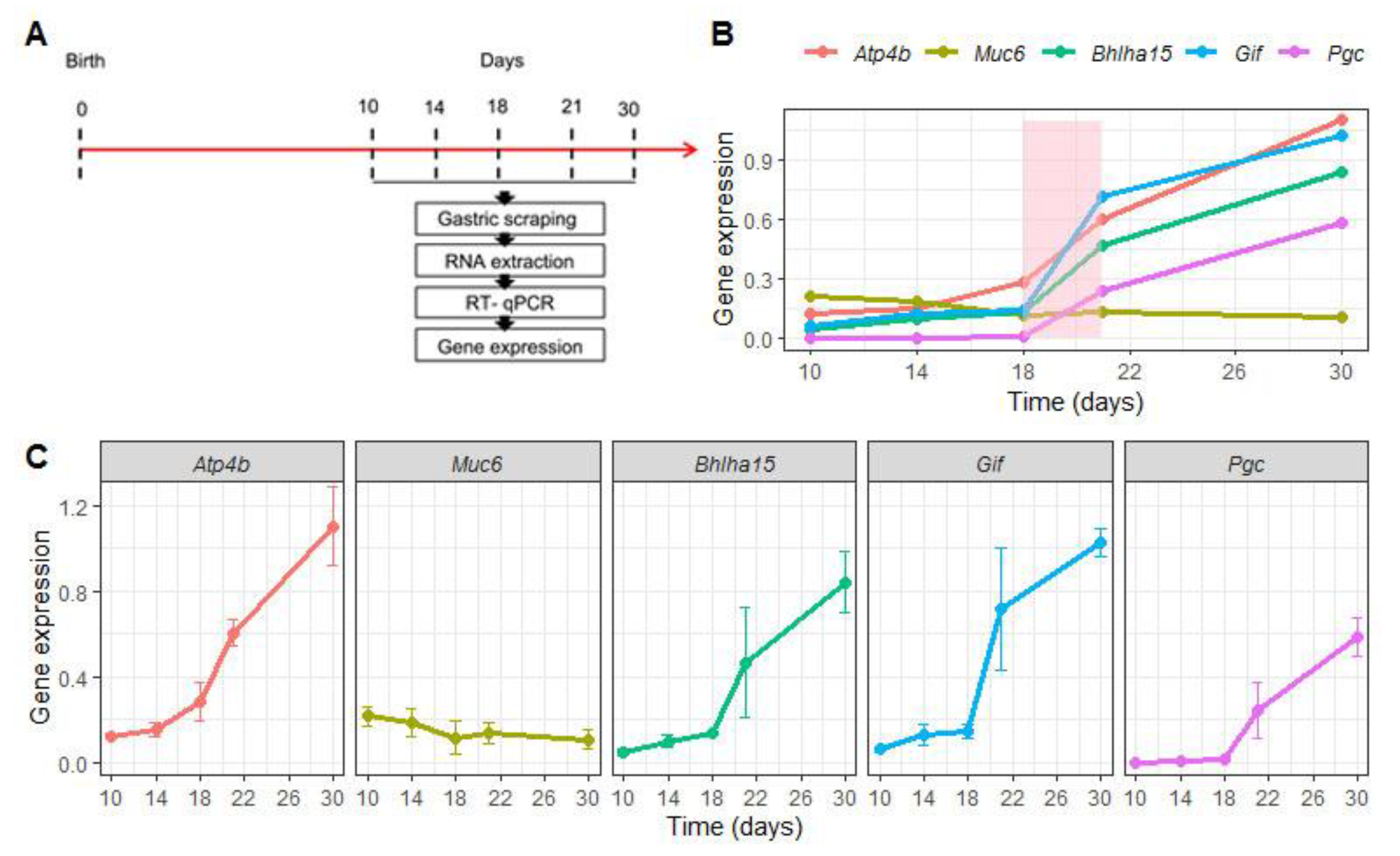

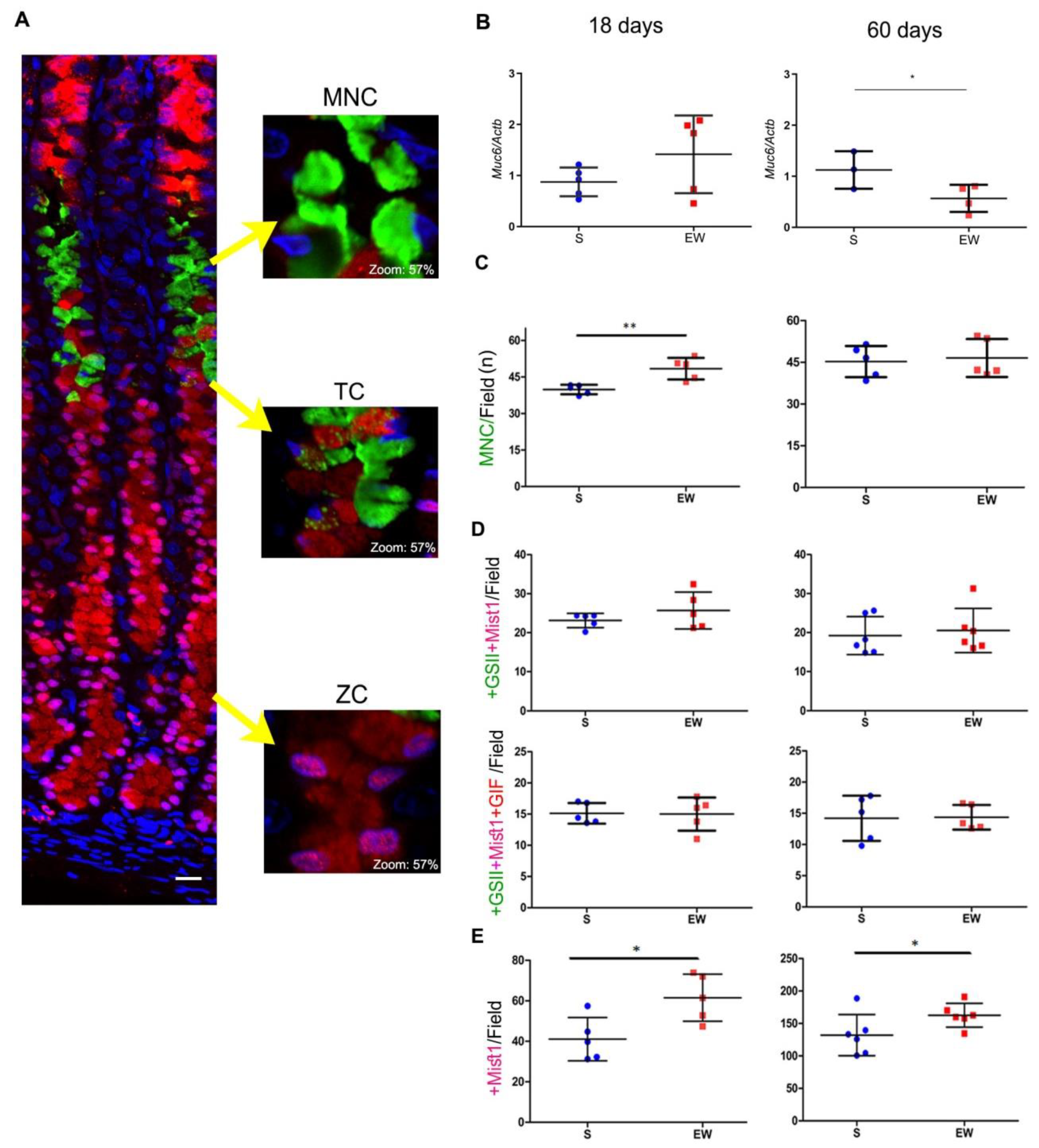
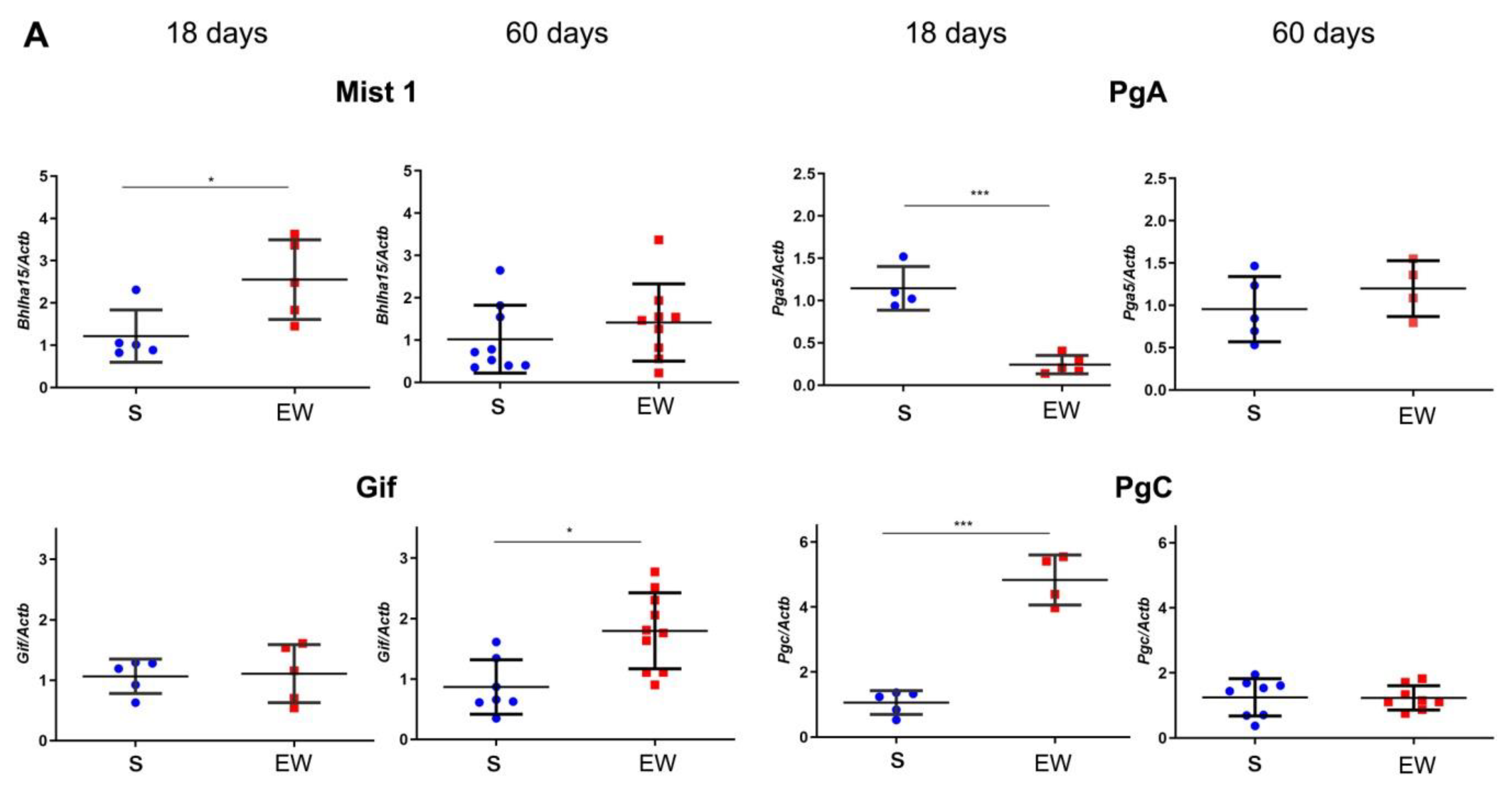
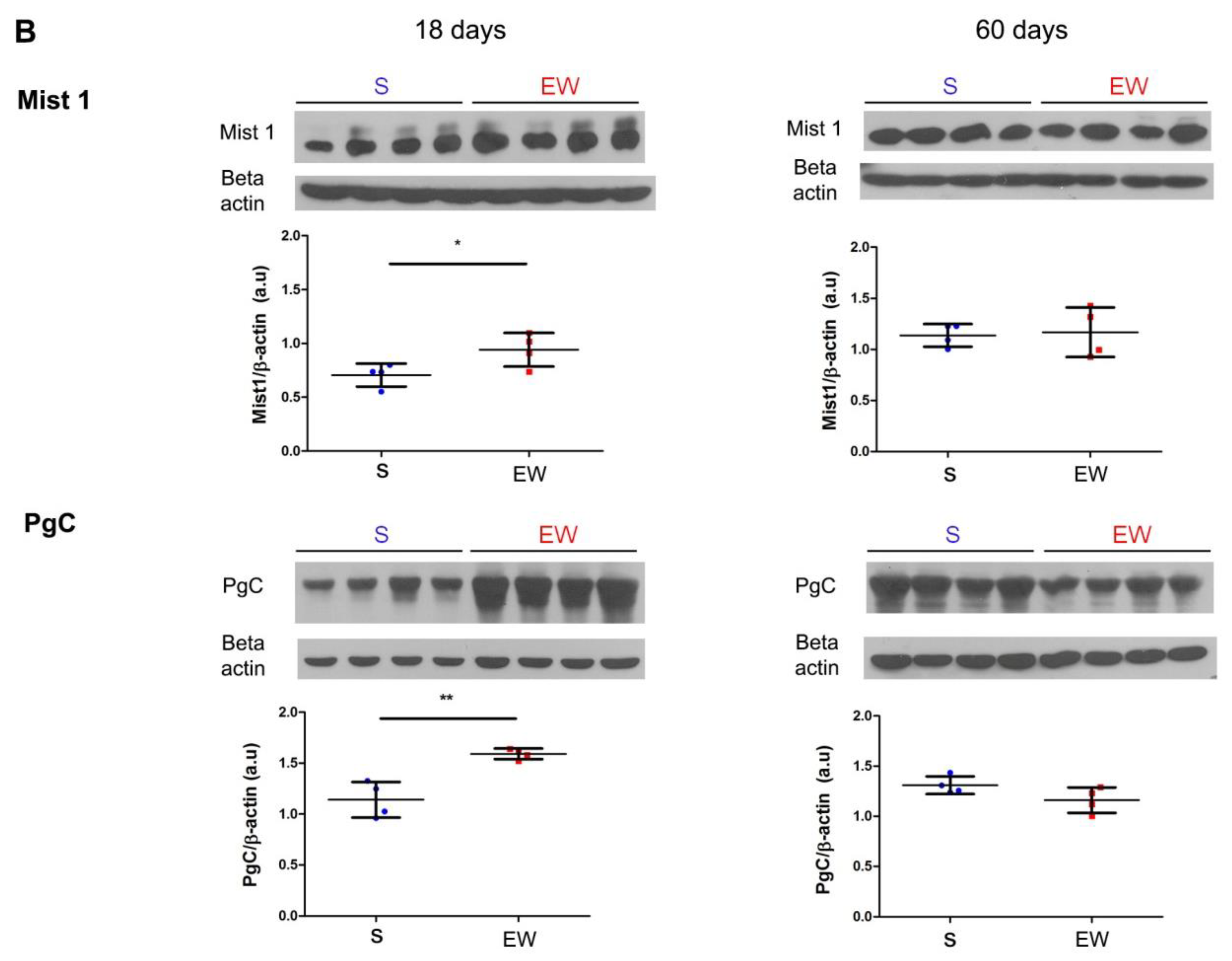

| Encoded Protein | Gene | Forward | Reverse |
|---|---|---|---|
| GAPDH | Gapdh | AGTGCCAGCCTCGTCTCATAG | TAACCAGGCGTCCGATACG |
| H+/K+ ATPase | Atp4a | TGCCCATCCGGTTCCA | TCCGGATCTCATCATAGACAAA |
| Mucin 6 | Muc6 | TACCTCTCACAGGAAGGACTACCAT | TCGTGTACTTGTTTTAGGTGGTGCTA |
| Mist1 | Bhlha15 * | GAACTTGTGCTTGGTCCATCCT | TCCCTATCCTGCGTTCACAAC |
| GIF | Gif | TGTGGCCCTGATCATGAAGT | TTGTTTATGGTGTATATGACTGTGA |
| Pepsinogen C | PgC | CTGGCTTCTTTGGCTATGACACT | CTCATTCTCACTCAGGCCAAACT |
| Encoded Protein | Gene | Assay ID |
|---|---|---|
| Beta-actin | Actb | Rn 00667869_m1 |
| ATPase H+/K+ | Atp4b | Rn 00560844_m1 |
| Mucin 6 | Muc6 | Rn 01759814_m1 |
| GIF | Gif | Rn 00567702_m1 |
| Pepsinogen 5a | Pg5a | Rn 00572739_m1 |
| Pepsinogen C | Pgc | Rn 00590984_m1 |
© 2019 by the authors. Licensee MDPI, Basel, Switzerland. This article is an open access article distributed under the terms and conditions of the Creative Commons Attribution (CC BY) license (http://creativecommons.org/licenses/by/4.0/).
Share and Cite
Teles Silva, M.; Mesquita da Silva, K.; Campos Rattes, I.; Maria Agostini Zonta, G.; Vasques da Costa, A.; Galvão Figueredo Costa, R.; Karen Cordeiro Nogueira, L.; Ogias, D.; Gama, P. Immediate and Late Effects of Early Weaning on Rat Gastric Cell Differentiation. Int. J. Mol. Sci. 2020, 21, 196. https://doi.org/10.3390/ijms21010196
Teles Silva M, Mesquita da Silva K, Campos Rattes I, Maria Agostini Zonta G, Vasques da Costa A, Galvão Figueredo Costa R, Karen Cordeiro Nogueira L, Ogias D, Gama P. Immediate and Late Effects of Early Weaning on Rat Gastric Cell Differentiation. International Journal of Molecular Sciences. 2020; 21(1):196. https://doi.org/10.3390/ijms21010196
Chicago/Turabian StyleTeles Silva, Melissa, Kethleen Mesquita da Silva, Isadora Campos Rattes, Gizela Maria Agostini Zonta, Aline Vasques da Costa, Raquel Galvão Figueredo Costa, Ludimila Karen Cordeiro Nogueira, Daniela Ogias, and Patricia Gama. 2020. "Immediate and Late Effects of Early Weaning on Rat Gastric Cell Differentiation" International Journal of Molecular Sciences 21, no. 1: 196. https://doi.org/10.3390/ijms21010196
APA StyleTeles Silva, M., Mesquita da Silva, K., Campos Rattes, I., Maria Agostini Zonta, G., Vasques da Costa, A., Galvão Figueredo Costa, R., Karen Cordeiro Nogueira, L., Ogias, D., & Gama, P. (2020). Immediate and Late Effects of Early Weaning on Rat Gastric Cell Differentiation. International Journal of Molecular Sciences, 21(1), 196. https://doi.org/10.3390/ijms21010196





